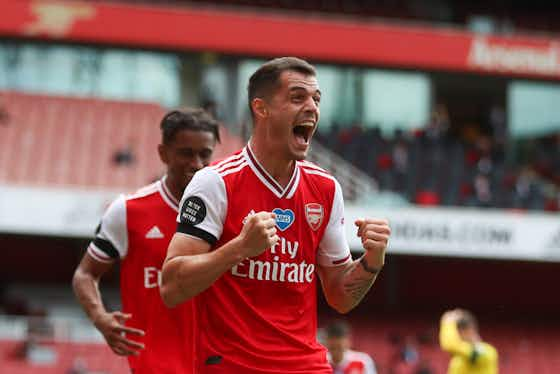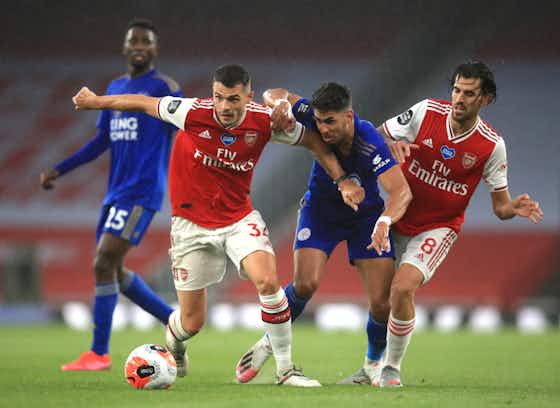ArseDevils
·5 October 2020
Revisit: How Granit Xhaka Went From ‘Misunderstood’ To Arsenal’s Most Important Midfielder

ArseDevils
·5 October 2020

It was two years ago that we published an article about Granit Xhaka, highlighting how the discourse around the Arsenal midfielder was very warped and misunderstood. And it is two years later – now – that the Swiss international has proven us right. Initially, the piece was met with harsh criticism on social media and a heated article from one of our writers at ArseDevils.
Nevertheless, this revisit is not to pen a million-word article just to yell “I told you so,” but rather to examine his journey to this point and how the appointment of Mikel Arteta managed to bloom him into the current state under his guidance.

During the 2018/19 season, the pairing of Lucas Torreira and Granit Xhaka resulted in one of the best run of games Arsenal have enjoyed in recent times. Unfortunately, it became clear by December and early January that the former Borrusia Monchengladbach man was compensating for the Uruguayan more than often.
And after Torreira’s form fell off, the Swiss international was yet again left as the only consistent presence in Arsenal’s midfield. Although Matteo Guendouzi had already impressed earlier that season, it became quite apparent that Unai Emery’s overuse of him led him to suffer a burnout.
This culminated into a 4-1 thrashing by Maurizio Sarri’s Chelsea in the Europa League final, as the midfield failed to perform. Nevertheless, the season ended and new names were brought into the mix to fix the woes of the previous campaign. Dani Ceballos came in as a solution to the Gunners losing Aaron Ramsey as his contract expired.
Guendouzi showed signs of regaining his form here and there, but never found his groove. Inconsistency was a trend that was apparent since the latter stages of his debut season, but one cannot blame a teenager for that. Torreira, on the other hand, never quite recovered from his dip in form – a course of things that eventually led to the conclusion that the first half of his debut season was a mere purple patch.
And although Ceballos impressed with his home debut against Burnley, he did not show the same level of performances in the latter months of the campaign. But that is expected of a new signing who is still adapting to the new league and team. Despite this, Emery more or less made it work with Xhaka as his official skipper. That was until late October when the midfielder reached a breaking point.
As we highlighted in the article we are currently following up on, the Albanian descendant was always overcriticised and scapegoated for all the wrong reasons. This is another discourse that continued into the 2019/20 season, which ultimately led to the incident at the Emirates against Crystal Palace.

Not diving into the whole drama of the incident, Granit Xhaka was stripped of the captaincy and dropped from the Arsenal squad for over 4 weeks. Emery – who was still the head coach at the time – publicly threw him under the bus in an attempt to shift the blame from his incompetent management.
The next time Granit Xhaka made an appearance for the Londoners, it ended in the most significant defeat of the decade for Arsenal. The loss would go on to put the nail in the coffin for the Spanish gaffer who was subsequently relieved of his duty; a few months late but alas.
Following the appointment of Freddie Ljungberg as interim manager, Xhaka went on to perform exceptionally. Although results were hard come by, it was understandable considering the circumstances. From then on, Arteta’s appointment would go on to become a pivotal change, not just for Arsenal, but also for Granit Xhaka.
The ex-Basel man had made up his mind to leave the Emirates Stadium but was convinced by the Spaniard to stay. The former Arsenal skipper managed to earn the midfielder’s trust, which laid the foundation for the system he would go on to implement.
To casual viewers, it would seem as if the new boss had turned the once “bang average” midfielder into a new player altogether. But to people who have watched him closely, it was obvious that Arteta merely allowed him to bloom into his best version.
The first thing the gaffer did was to divide responsibilities in midfield, in a much more structured and efficient way. This lowered the load on the Swiss and subsequently, allowed him to perform without being subjected to mistakes.

A rejuvenated Ceballos was preferred over Torreira, who is in Spain to complete his move to Atletico Madrid. The Real Madrid loanee was also subjected to bizarre roles under Emery, which was quickly changed under Pep Guardiola’s former right-hand man.
What Arteta accomplished that his predecessor did not was creating a system that did not fail his own midfielders. It was something insanely simple in hindsight, but not quite easy to implement. And thus, the North Londoners led a charge in which they would go on to defeat Manchester United, Liverpool, Manchester City in the FA Cup semi-final, and Chelsea in the FA Cup final – games in which the new midfield duo would shine as the vital cogs to their new system.
Alas, Arsenal is a work in progress and things aren’t yet perfect. Though the FA Cup win qualified the Emirates outfit for the Europa League, a top-six finish was not meant to be.
Nevertheless, an exemplary campaign from the once “disgraced captain” set the tone for how players can bloom under the new Gunners boss. The midfielder finished the campaign as his side’s best midfielder and one of the most important players in the squad.
He also recorded 2 assists and a goal whilst creating 1 big chance in the Premier League. Completing 88% of his passes and 68% of long balls, which is nothing short of impressive, especially for someone who is often regarded as a sloppy player. With 48% of his passes being forward, he was also a progressive presence in midfield.
Defensively, the No. 6 averaged 1.5 tackles, 4.7 duels won and a foul won every 90 minutes, whilst also registering 1.8 chances per 90 with a 78% dribble completion rate. And even in the absence of Ceballos, who left for Madrid following the end of his loan spell, Xhaka dominated Liverpool’s midfield in the Community Shield with Mohamed Elneny next to him and led his side to victory.
The narrative around the Switzerland captain is changing following this transition. But it has also given birth to a new narrative that insists he was never good before the arrival of Arteta, a claim that can be easily be proven otherwise.
And if stats aren’t something you would trust, just look back at his career. A starter and/or captain under Arsene Wenger, Emery, Ljungberg, and Arteta. All these managers working at the highest level of football cannot be blind.
Arteta himself revealed that City had considered signing him before he arrived in North London. Guardiola also looked at the prospect of importing him as Xabi Alonso’s replacement during his time at Bayern Munich. But online experts will claim he was or is no good.
Some people still claim Granit Xhaka is not a good player, arguing that “a few performances” do not change their judgement. And to them, I shall say exactly what I said in my previous article – if one still refuses to acknowledge his ability and performances, they simply cannot appreciate greatness.


Live





























































